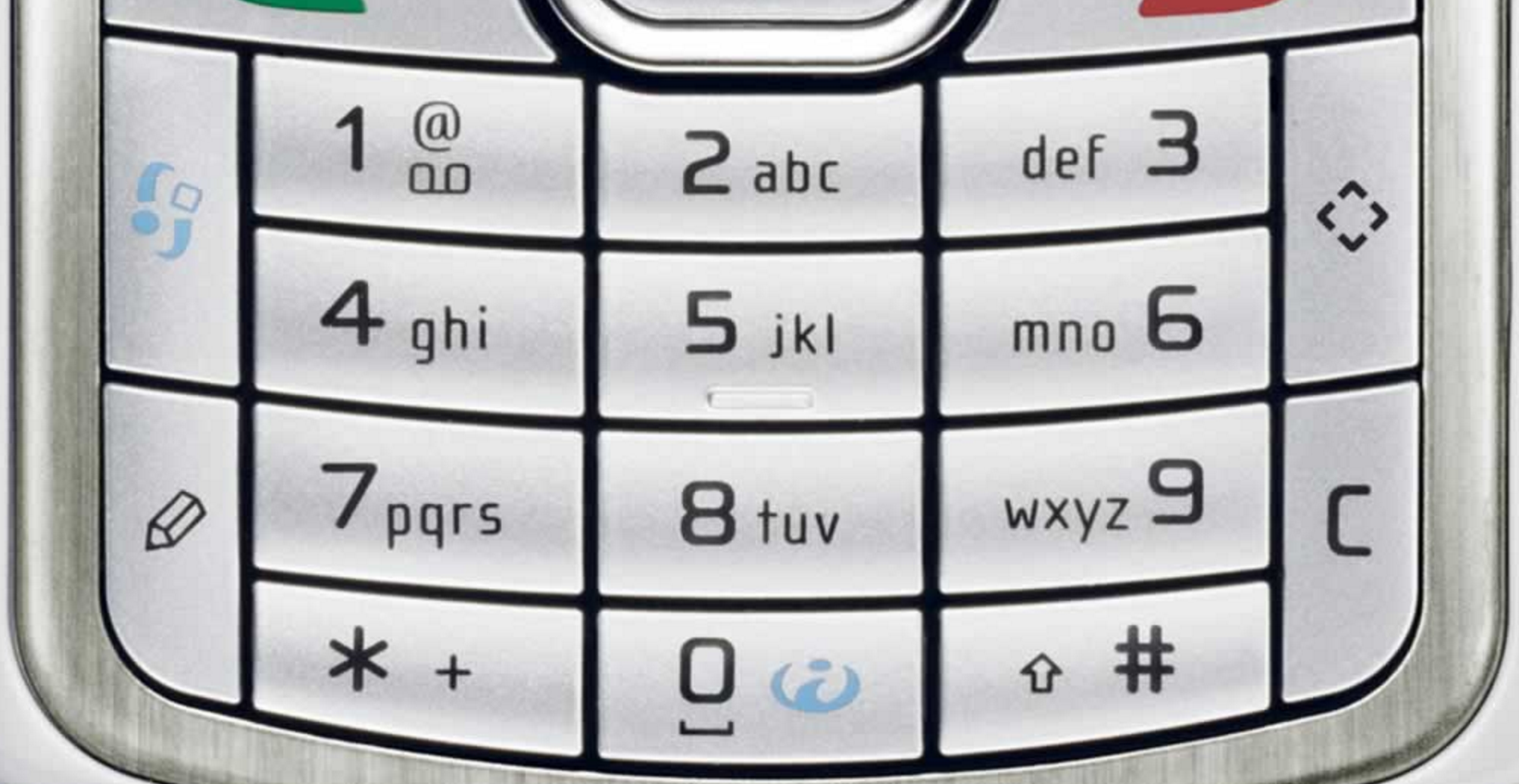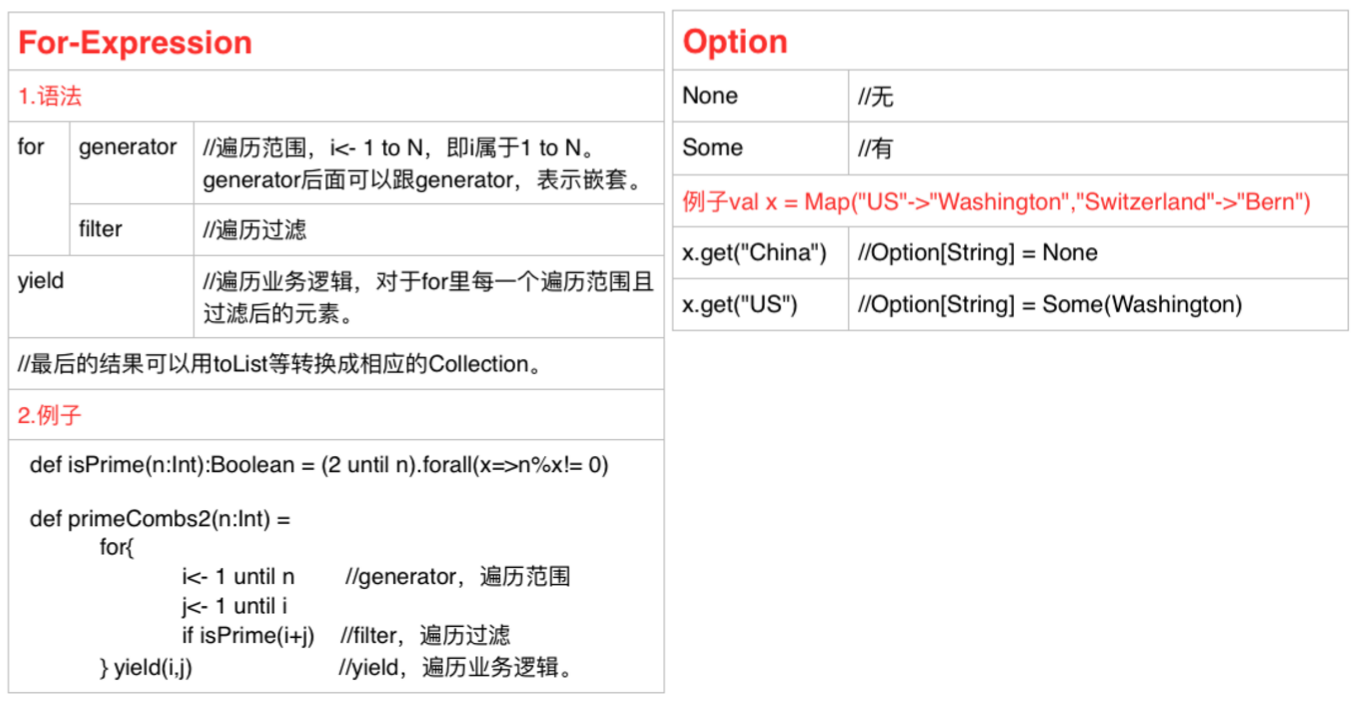目录
1. 介绍
2. collection
2.1 可选值
Option(可选值):有两个子类,一个是None,一个是Some。这是Scala表示有和无的一种处理。我们再回顾下上文中
Map的get方法。
1
2
3
4
5
val capitalOfCountry = Map("US"->"Washington","Switzerland"->"Bern")
//Map(US -> Washington, Switzerland -> Bern)
capitalOfCountry("US") //String = Washington
capitalOfCountry.get("China") //Option[String] = None
capitalOfCountry.get("US") //Option[String] = Some(Washington)
有和无的处理一直是programming中的一个无法避免的问题,有些时候,函数返回非正常值来代替无,比如List的方法indexOf(x)返回下标若有x,返回-1若没有x。这会带来一些额外的问题,比如编程者需要把结果和-1判断才能知道是不是有x,这就提前假定了编程者知道-1在List类里的含义。如果我们用Option就不需要有这种担忧,直接和None比较即可。Swift中对于Option有大量的应用,只要随便翻开Swift的代码,里面一定充满了?和!,这就是对于Option的拆包的操作。
2.2 for-expression
Scala的函数式也有自己的for循环的语法,相比较于命令式的for循环,scala的for循环更简洁,而且是基于对数据的转换而不是更改。下面举一个栗子。
质数问题:给定一个自然数n,求所有的组合(i,j),满足i+j为质数,且1<=j<i<N。
我们用之前的高阶函数的实现如下:
1
2
3
def isPrime(n:Int):Boolean = (2 until n).forall(x=>n%x!= 0)
def primeCombs1(n:Int)= ((1 until n).flatMap(i=>(1 until i).map(j=>(i,j)))).filter(pair=>isPrime(pair._1 + pair._2))
这种语法看起来不是非常容易理解。那么如果我们用Scala的for循环语句的实现是什么样子呢?
1
2
3
4
5
6
7
8
def isPrime(n:Int):Boolean = (2 until n).forall(x=>n%x!= 0)
def primeCombs2(n:Int) =
for{
i<- 1 until n //generator,遍历范围
j<- 1 until i
if isPrime(i+j) //filter,遍历过滤
} yield(i,j) //yield,遍历业务逻辑。
for语句使得我们的代码看起来更简洁易懂。
2.2.1 for-expression语法
for-expression的语法有三部分:
generator,也就是for循环的单个元素。“左边<-右边” 表示左边是右边(Collection)的元素。genertor后面可以再跟generator表示嵌套;filter跟在generator后面,用if表示;yield表示对于for{}里的每个符合filter的来自generator的元素,我们的处理。这里是生成一个tuple(i,j)。最后的结果这里是IndexedSeq[(Int,Int)]。我们可以将结果toList转成List。
总结起来generator和filter分别是遍历范围和条件,而yield是遍历业务逻辑。
2.2.2 for-expression as Query for Database
由于Scala for-expression的简洁强大,它可以用于数据库查询。我们看下面这个例子。
1
2
3
4
5
6
7
8
9
10
11
12
13
14
15
16
17
18
19
20
21
22
case class Book(title:String, authors:List[String])
val books:List[Book] = List(new Book(title = "Structure and Interpretation of Computer Programs", authors = List("Abelson, Harald", "Sussman, Gerald J.")),
new Book(title = "Introduction to Functional Programming", authors = List("Bird, Richard", "Wadler, Phil")),
new Book(title = "Effective Java", authors = List("Bloch, Joshua")),
new Book(title = "Effective Java2", authors = List("Bloch, Joshua")),
new Book(title = "Java Puzzlers", authors = List("Bloch, Joshua", "Gafter, Neal")),
new Book(title = "Programming in Scala", authors = List("Odersky, Martin","Spoon, Lex", "Venners, Bill"))
)
for(b<-books; a<-b.authors if a.startsWith("Bloch")) yield b.title
//List(Effective Java, Effective Java2, Java Puzzlers)
(for{b1<-books
b2<-books
if b1.title < b2.title
a1<-b1.authors
a2<-b2.authors
if a1==a2
} yield a1
).distinct //or toSet,结果是List(Bloch, Joshua)
第一个查询是列出books中作者名字以”Block”开头的书本名字;第二个查询稍微复杂点,是列出books中写出两本以上书的作者的名字,.distinct或者toSet是将结果中重复的剔除掉。
我们可以看到Scala的for-expression用于数据库查询也十分紧凑明了。数据库查询框架ScalaQuery,Slick和Microsoft’s LINQ都是基于Scala的for-expression来实现的。
Scala的for-expression的实现是基于filter,map和flatMao这三种高阶函数。本质上来说for-expression是语法糖,让开发者代码写起来简单易懂又不失其强大。
2.3 例子
我们将所学的Collection数据结构以及可选值和for表达式结合在一起,来解决一个具体问题。
号码字母问题:给定一个数字,返回所有可能的单词。数字和字母的对应关系如下图所示。即”2”->”ABC”,…,”9”->”wxyz”。如果我们输入是”7225247386”,其中一个输出是”scala is fun”。

我们用top-down一步步思考该如何实现:
-
首先,我们有一个
encode(number:String):Set[String],输入一个数字,返回最后答案的Set。因为答案不能有重复,所以Set比较合适。这个方法的实现主要用到分而治之的思想:1.1 将数字拆解成两部分,第一部分求解;然后第二部分求解;
1.2 将结果merge。 -
求解过程中有一个函数
numberToWords(number:String):Set[String],即给定了一个数字(不可拆分),输出所有可能的单词。那么如何实现呢,我们设想有一个val numberToWordsMap: Map[String,List[String]],任何数字的对应单词都已经存在里面了。那么我们只需要调用这个Map即可。 -
numberToWordsMap需要我们将已有的单词字典里的每个单词都写成数字def encodeWord(word:String):Int,然后按照数字归类。 -
def encodeWord(word:String):Int需要实现将字母写成单个数字def encodeChar(char:Char): Int。 -
def encodeChar(char:Char): Int需要将上图Nokia键盘的数字转换字母规则转换成字母转换数字规则。 -
课程提供了一个简易字典文件,最后我们将上述所有连接起来,就是最终实现了。见下面代码。
1
2
3
4
5
6
7
8
9
10
11
12
13
14
15
16
17
18
19
20
21
22
23
24
25
26
27
28
29
30
31
32
33
34
35
36
37
38
39
40
41
42
43
44
45
46
47
48
49
50
51
52
53
import scala.io.Source
import scala.collection.immutable.List
object lecture7 {
import scala.io.Source
import scala.collection.immutable.List
object lecture7 {
val in = Source.fromFile("/Users/LAL/Scala/hello-project/src/week6/dict/linux.words")
val words = in.getLines.toVector.filter(word=>word.forall(lt=>lt.isLetter))
val numbToLettsMap:Map[Char,String]= Map('2'->"ABC",'3'->"DEF",'4'->"GHI",'5'->"JKL",
'6'->"MNO",'7'->"PQRS",'8'->"TUV",'9'->"WXYZ")
//> numbToLettsMap : Map[Char,String] = Map(8 -> TUV, 4 -> GHI, 9 -> WXYZ, 5 -
//| > JKL, 6 -> MNO, 2 -> ABC, 7 -> PQRS, 3 -> DEF)
/**Invert the mnem map to give a map from chars 'A'...'Z' to '2'...'9'*/
val charCode:Map[Char,Char] = for ((numb,letts)<-numbToLettsMap;lett<-letts) yield lett->numb
//> charCode : Map[Char,Char] = Map(E -> 3, X -> 9, N -> 6, T -> 8, Y -> 9, J
//| -> 5, U -> 8, F -> 3, A -> 2, M -> 6, I -> 4, G -> 4, V -> 8, Q -> 7, L ->
//| 5, B -> 2, P -> 7, C -> 2, H -> 4, W -> 9, K -> 5, R -> 7, O -> 6, D -> 3,
//| Z -> 9, S -> 7)
/**Maps a word to the digit string it can represent, e.g. "Java"->"5282"*/
def wordCode(word:String):String = word.toUpperCase.map(charCode)
//> wordCode: (word: String)String
/**
*A map from digit strings to the words that represent them
*e.g. "5282" -> List("Java","Kata","Lava",...)
*Note: A missing nuber should map tot he empty set,e.g. "1111" -> List()
*/
def numbToWordMap:Map[String,Vector[String]] = words.groupBy(wordCode).withDefaultValue(Vector())
//> numbToWordMap: => Map[String,Vector[String]]
/**Return all ways to encode a number as a list of words*/
def encode(numb: String):Set[List[String]] =
if (numb.isEmpty) Set(List())
else{
for{
part<-1 to numb.length
result<-numbToWordMap(numb.take(part))
rest<-encode(numb.drop(part))
} yield result::rest
}.toSet //> encode: (numb: String)Set[List[String]]
println(encode("7225247386")) //> Set(List(rack, ah, re, to), List(sack, ah, re, to), List(Scala, ire, to), L
//| ist(sack, air, fun), List(rack, air, fun), List(rack, bird, to), List(pack,
//| air, fun), List(pack, ah, re, to), List(pack, bird, to), List(Scala, is, f
//| un), List(sack, bird, to))
def transform(numb: String):Set[String] = encode(numb).map(_.mkString(" "))
//> transform: (numb: String)Set[String]
println(transform("7225247386")) //> Set(sack air fun, pack ah re to, pack bird to, Scala ire to, Scala is fun,
//| rack ah re to, pack air fun, sack bird to, rack bird to, sack ah re to, rac
//| k air fun)
}
关于这个例子,有一篇文章An empirical comparison of C, C++, Java, Perl, Python, Rexx, and Tcl for a search/string-processing program专门比较了7种语言实现的不同。其中:
- 脚本语言用了大约100loc(line of code);
- 非脚本语言用了大约200-300loc。
对比一下scala,20loc以内解决问题,而且不用担心遍历Collection时的边界条件,实在令我们印象深刻。Scala函数式语言的强大可见一斑,这主要依赖基于函数式数据结构实现的Collection的强大且简捷的高阶函数。
3 Assignment
本周的作业是写Sentence的Anagram,其中foldLeft的紧凑在这里得到了良好的体现,本来需要好十几行的代码,用foldLeft几行就能解决,其中巧妙,需要细细体会。foldLeft其实是对monoids的一种应用。monoids将在后续文章中讨论。
1
2
3
4
5
6
7
8
9
10
11
12
13
14
15
16
17
18
19
20
21
22
23
24
25
26
27
28
29
30
31
32
/**
* Returns the list of all subsets of the occurrence list.
* This includes the occurrence itself, i.e. `List(('k', 1), ('o', 1))`
* is a subset of `List(('k', 1), ('o', 1))`.
* It also include the empty subset `List()`.
*
* Example: the subsets of the occurrence list `List(('a', 2), ('b', 2))` are:
*
* List(
* List(),
* List(('a', 1)),
* List(('a', 2)),
* List(('b', 1)),
* List(('a', 1), ('b', 1)),
* List(('a', 2), ('b', 1)),
* List(('b', 2)),
* List(('a', 1), ('b', 2)),
* List(('a', 2), ('b', 2))
* )
*
* Note that the order of the occurrence list subsets does not matter -- the subsets
* in the example above could have been displayed in some other order.
*/
def combinations(occurrences: Occurrences): List[Occurrences] = {
occurrences.foldLeft(List[Occurrences](Nil))((acc, item) => {
for {
oc <- acc //oc: List[(Char,Int)]
x <- (for (i <- 0 to item._2) yield (item._1, i)).toList //x: (Char,Int)
} yield if (x._2 == 0) oc else oc ++ List(x)
})
}
具体代码见这里。
4 总结
